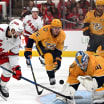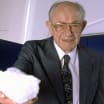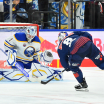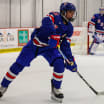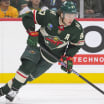VANCOUVER -- Martin Brodeur was just a teenager growing up in Montreal when his father planted the seed that would change the goaltending position forever.
Denis Brodeur was a photographer for the Montreal Canadiens at the time and couldn't wait to tell his son what he saw during a game against the Philadelphia Flyers.
Playing puck helped Brodeur revolutionize position
Goaltender's stickhandling prowess was key part of Devils' attack
By
Kevin Woodley
NHL.com Independent Correspondent
"When I woke up before going to school my dad came in and said, 'Son, I can't believe what I saw last night,' and I didn't see the game so I didn't know what he was talking about, but Ron Hextall was playing and he said, 'This guy is like a third defenseman,'" Brodeur once told NHL.com. "That stuck in my mind and next thing you know I watched a game and saw him play and I was amazed and I thought, 'You know what, that's what I want to do, I want to put that in my game.' And so I started working at it."
When Brodeur retired in 2015 his name was etched into 13 NHL trophies and atop more than 20 NHL records, in most cases with a big lead over the next name on the list.
So it seems a little surprising that Brodeur, whose 22-season career is being celebrated for four days leading up to the New Jersey Devils retiring his No. 30 on Tuesday, actually finished third on the all-time NHL regular-season assist list behind Tom Barrasso and Grant Fuhr with 45 career assists, and one behind Barrasso on the points list with 47.
It's also a little ironic, because for all the awards and accolades he accumulated stopping pucks, it was Brodeur's ability to play the puck that may have left the greatest mark on the game.
Sure, Hextall started the trend that inspired him, and by the time Brodeur retired other goalies like Marty Turco could arguably pass it more spectacularly. But Brodeur and the Devils redefined how a goaltender's puck-handling skill could be used by a team, building his passing prowess into their stifling defensive system, and using his puck-moving abilities to get out of their end quick and clean and moving back the other way on offense.
Brodeur does top the NHL point list for goalies when you add his 13 in the Stanley Cup Playoffs, and he is the only goalie with two regular-season goals, and three overall when you add his playoff goal. He is also the only goalie to score a game-winner, and when the League introduced the trapezoid behind the net for the 2005-06 season to limit where goaltenders could play the puck, many referred to it as "the Brodeur rule."
Brodeur said all his success playing the puck started with that suggestion from his father Denis, who passed away on Sept. 26, 2013 at age 82, and a lot of work after.
"I was 14 or 15 years old when I started to work at it," Brodeur told NHL.com late in his playing career. "I just remember when I was midget AAA, we had hockey and school together, so we had a class of hockey and I would just go into the gym and shoot those big heavy orange pucks for half an hour just to get stronger. The key is you've got to play with the puck, you've got to practice, and you have to love what you do."
There was never much doubt about that when it came to Brodeur and playing goal, but the secret to his success playing the puck was also about not falling in love with the spectacular pass. When Mike McKenna, who spent two of his 11 pro seasons in the Devils organization and is highly regarded for his puck handling, wrote an article for InGoal Magazine sharing advice on playing the puck, one of the key points was how Brodeur didn't always look for a 60-foot breakout pass, instead relying on smart, subtle fakes, angle changes and soft chips to elude forecheckers and find teammates.
"Hextall revolutionized the position with his ability to shoot great distances at a high altitude: Never before had a goalie cleared the zone by physically shooting the puck over the heads of oncoming forecheckers," McKenna said. "But everything changed with Marty. He could do more than stop the puck and occasionally clear the zone. His intelligence and awareness allowed him to make plays. Passes, chips, clears, bumps, delays; Marty could do it all. And most importantly, his team took immediate notice and allowed him room to do so. Before long, Brodeur truly was the Devils' third defenseman on the ice, working seamlessly with teammates to initiate the breakout."
How well it worked in New Jersey was a product of hard work by Brodeur, whose own advice for young goaltenders focused on handling it as often as possible.
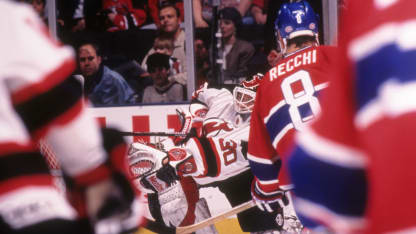
© Bruce Bennett/Getty Images
"The key to it is simply shooting pucks," Brodeur told NHL.com. "Every time I have a chance I'm going to make a pass to one of my players in practice. Every time I have a chance I'm going to clear the puck just to see how far I'm going to be able to shoot it. And when they're doing drills on the other side and I don't feel like taking shots, I go and I take maybe 50 pucks and I'm going to aim at the cross bar, or aim just over the net, and you know I'll shoot on my backhand, on my forehand, or from behind the net I'll get someone to skate board to board at the red line and I'll try to hit his stick."
Brodeur hit teammate's sticks more often than the opponents, but his playmaking ability served another purpose as well. For all those who might want to diminish some of Brodeur's accomplishments because he played behind a stingy Devils defense that his puck handling was a big part of, a lot of his puck-stopping peers have marveled at how he was able to stay sharp on the many nights when he wasn't overly busy, especially as a goalie who played with a lot of movement and flow that relies on timing and rhythm.
Nashville Predators goaltender Pekka Rinne is among those that admire Brodeur's ability to do so, and as he tries to find his own balance seeing fewer shots, recognizes that staying involved in those games by handling the puck more can play a big role.
"That's one of the things I am trying to do too," Rinne said of handling the puck as often as he can. "I feel like that helps me try to stay engaged in the game all the time."
It's one more example of how Brodeur changed goaltending, often when he wasn't even making a save.
